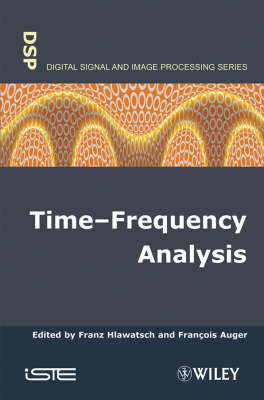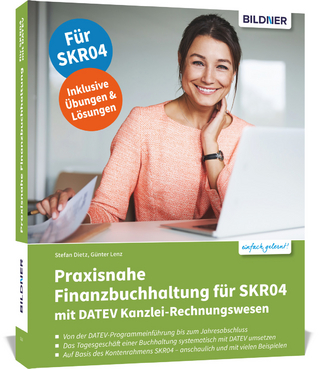
Time-Frequency Analysis
ISTE Ltd and John Wiley & Sons Inc (Verlag)
978-1-84821-033-2 (ISBN)
Franz Hlawatsch is an Associate Professor at the Vienna University of Technology, Austria. His research interests are in the areas of time-frequency signal processing, non-stationary statistical signal processing and wireless communications. Francois Auger is Head of the Physical Measurements Department of the Technology Institute of the University of Saint Nazaire, France. His current research interests include motor control, embedded control and signal processing with FPGAs, spectral estimation and time-frequency representations.
Preface 13
FIRST PART. FUNDAMENTAL CONCEPTS AND METHODS 17
Chapter 1. Time-Frequency Energy Distributions: An Introduction 19
Patrick FLANDRIN
1.1. Introduction 19
1.2. Atoms 20
1.3. Energy 21
1.3.1. Distributions 22
1.3.2. Devices 22
1.3.3. Classes 23
1.4. Correlations 26
1.5. Probabilities 27
1.6. Mechanics 29
1.7. Measurements 29
1.8. Geometries 32
1.9. Conclusion 33
1.10.Bibliography 34
Chapter 2. Instantaneous Frequency of a Signal 37
Bernard PICINBONO
2.1. Introduction 37
2.2. Intuitive approaches 38
2.3. Mathematical definitions 40
2.3.1. Ambiguity of the problem 40
2.3.2. Analytic signal and Hilbert transform 40
2.3.3. Application to the definition of instantaneous frequency 42
2.3.4. Instantaneous methods 45
2.4. Critical comparison of the different definitions 46
2.4.1. Interest of linear filtering 46
2.4.2. Bounds of the quantities introduced 46
2.4.3. Instantaneous nature 47
2.4.4. Interpretation by the average 48
2.5. Canonical pairs 49
2.6. Phase signals 50
2.6.1. Blaschke factors 50
2.6.2. Oscillatory singularities 54
2.7. Asymptotic phase signals 57
2.7.1. Parabolic chirp 57
2.7.2. Cubic chirp 59
2.8. Conclusions 59
2.9. Bibliography 60
Chapter 3. Linear Time-Frequency Analysis I: Fourier-Type Representations 61
Remi GRIBONVAL
3.1. Introduction 61
3.2. Short-time Fourier analysis 62
3.2.1. Short-time Fourier transform 63
3.2.2. Time-frequency energy maps 64
3.2.3. Role of the window 66
3.2.4. Reconstruction/synthesis 71
3.2.5. Redundancy 71
3.3. Gabor transform; Weyl-Heisenberg and Wilson frames 71
3.3.1. Sampling of the short-time Fourier transform 71
3.3.2. Weyl-Heisenberg frames 72
3.3.3. Zak transform and “critical” Weyl-Heisenberg frames 74
3.3.4. Balian-Low theorem 75
3.3.5. Wilson bases and frames, local cosine bases 75
3.4. Dictionaries of time-frequency atoms; adaptive representations 77
3.4.1. Multi-scale dictionaries of time-frequency atoms 77
3.4.2. Pursuit algorithm 78
3.4.3. Time-frequency representation 79
3.5. Applications to audio signals 80
3.5.1. Analysis of superimposed structures 80
3.5.2. Analysis of instantaneous frequency variations 80
3.5.3. Transposition of an audio signal 82
3.6. Discrete algorithms 82
3.6.1. Fast Fourier transform 83
3.6.2. Filter banks: fast convolution 83
3.6.3. Discrete short-time Fourier transform 85
3.6.4. Discrete Gabor transform 86
3.7. Conclusion 86
3.8. Acknowledgements 87
3.9. Bibliography 87
Chapter 4. Linear Time-Frequency Analysis II: Wavelet-Type Representations 93
Thierry BLU and Jerome LEBRUN
4.1. Introduction: scale and frequency 94
4.2. Continuous wavelet transform 95
4.2.1. Analysis and synthesis 95
4.2.2. Multiscale properties 97
4.3. Discrete wavelet transform 98
4.3.1. Multi-resolution analysis 98
4.3.2. Mallat algorithm 104
4.3.3. Graphical representation 106
4.4. Filter banks and wavelets 107
4.4.1. Generation of regular scaling functions 108
4.4.2. Links with approximation theory 111
4.4.3. Orthonormality and bi-orthonormality/perfect reconstruction 112
4.4.4. Polyphase matrices and implementation 114
4.4.5. Design of wavelet filters with finite impulse response 114
4.5. Generalization: multi-wavelets 116
4.5.1. Multi-filter banks 116
4.5.2. Balancing and design of multi-filters 118
4.6. Other extensions 121
4.6.1. Wavelet packets 121
4.6.2. Redundant transformations: pyramids and frames 122
4.6.3. Multi-dimensional wavelets 123
4.7. Applications 124
4.7.1. Signal compression and denoising 124
4.7.2. Image alignment 125
4.8. Conclusion 125
4.9. Acknowledgments 126
4.10. Bibliography 126
Chapter 5. Quadratic Time-Frequency Analysis I: Cohen’s Class 131
Francois AUGER and Eric CHASSANDE-MOTTIN
5.1. Introduction 131
5.2. Signal representation in time or in frequency 132
5.2.1. Notion of signal representation 132
5.2.2. Temporal representations 133
5.2.3. Frequency representations 134
5.2.4. Notion of stationarity 135
5.2.5. Inadequacy of monodimensional representations 136
5.3. Representations in time and frequency 137
5.3.1. “Ideal” time-frequency representations 137
5.3.2. Inadequacy of the spectrogram 140
5.3.3. Drawbacks and benefits of the Rihaczek distribution 142
5.4. Cohen’s class 142
5.4.1. Quadratic representations covariant under translation 142
5.4.2. Definition of Cohen’s class 143
5.4.3. Equivalent parametrizations 144
5.4.4. Additional properties 145
5.4.5. Existence and localization of interference terms 148
5.5. Main elements 155
5.5.1. Wigner-Ville and its smoothed versions 155
5.5.2. Rihaczek and its smoothed versions 157
5.5.3. Spectrogram and S transform 158
5.5.4. Choi-Williams and reduced interference distributions 158
5.6. Conclusion 159
5.7. Bibliography 159
Chapter 6. Quadratic Time-Frequency Analysis II: Discretization of Cohen’s Class 165
Stephane GRASSIN
6.1. Quadratic TFRs of discrete signals 165
6.1.1. TFRs of continuous-time deterministic signals 167
6.1.2. Sampling equation 167
6.1.3. The autocorrelation functions of the discrete signal 168
6.1.4. TFR of a discrete signal as a function of its generalized ACF 169
6.1.5. Discussion 171
6.1.6. Corollary: ambiguity function of a discrete signal 172
6.2. Temporal support of TFRs 173
6.2.1. The characteristic temporal supports 173
6.2.2. Observations 175
6.3. Discretization of the TFR 176
6.3.1. Meaning of the frequency discretization of the TFR 176
6.3.2. Meaning of the temporal discretization of the TFR 176
6.3.3. Aliased discretization 177
6.3.4. “Non-aliased”discretization 179
6.4. Properties of discrete-time TFRs 180
6.4.1. Discrete-time TFRs 181
6.4.2. Effect of the discretization of the kernel 182
6.4.3. Temporal inversion 182
6.4.4. Complexcon jugation 183
6.4.5. Real-valued TFR 183
6.4.6. Temporal moment 183
6.4.7. Frequency moment 184
6.5. Relevance of the discretization to spectral analysis 185
6.5.1. Formulation of the problem 185
6.5.2. Trivial case of a sinusoid 187
6.5.3. Signal with linear frequency modulation 187
6.5.4. Spectral analysis with discretized TFRs 188
6.6. Conclusion 189
6.7. Bibliography 189
Chapter 7. Quadratic Time-Frequency Analysis III: The Affine Class and Other Covariant Classes 193
Paulo GONCALVES, Jean-Philippe OVARLEZ and Richard BARANIUK
7.1. Introduction 193
7.2. General construction of the affine class 194
7.2.1. Bilinearity of distributions 194
7.2.2. Covariance principle 195
7.2.3. Affine class of time-frequency representations 198
7.3. Properties of the affine class 201
7.3.1. Energy 201
7.3.2. Marginals 202
7.3.3. Unitarity 202
7.3.4. Localization 203
7.4. Affine Wigner distributions 206
7.4.1. Diagonal form of kernels 206
7.4.2. Covariance to the three-parameter affine group 209
7.4.3. Smoothed affine pseudo-Wigner distributions 211
7.5. Advanced considerations 216
7.5.1. Principle of tomography 216
7.5.2. Operators and groups 217
7.6. Conclusions 222
7.7. Bibliography 223
SECOND PART. ADVANCED CONCEPTS AND METHODS 227
Chapter 8. Higher-Order Time-Frequency Representations 229
Pierre-Olivier AMBLARD
8.1. Motivations 229
8.2. Construction of time-multifrequency representations 230
8.2.1. General form and desirable properties 230
8.2.2. General classes in the symmetric even case 231
8.2.3. Examples and interpretation 236
8.2.4. Desired properties and constraints on the kernel 237
8.2.5. Discussion 239
8.3. Multilinear time-frequency representations 240
8.3.1. Polynomial phase and perfect concentration 240
8.3.2. Multilinear time-frequency representations: general class 242
8.4. Towards affine multilinear representations 243
8.5. Conclusion 246
8.6. Bibliography 247
Chapter 9. Reassignment 249
Eric CHASSANDE-MOTTIN, Francois AUGER, and Patrick FLANDRIN
9.1. Introduction 249
9.2. The reassignment principle 250
9.2.1. Classical tradeoff in time-frequency and time-scale analysis 250
9.2.2. Spectrograms and scalograms re-examined and corrected by mechanics 252
9.2.3. Generalization to other representations 254
9.2.4. Link to similar approaches 257
9.3. Reassignment at work 257
9.3.1. Fast algorithms 258
9.3.2. Analysis of a few simple examples 259
9.4. Characterization of the reassignment vector fields 265
9.4.1. Statistics of the reassignment vectors of the spectrogram 265
9.4.2. Geometrical phase and gradient field 267
9.5. Two variations 269
9.5.1. Supervised reassignment 269
9.5.2. Differential reassignment 270
9.6. An application: partitioning the time-frequency plane 271
9.7. Conclusion 274
9.8. Bibliography 274
Chapter 10. Time-Frequency Methods for Non-stationary Statistical Signal Processing 279
Franz HLAWATSCH and Gerald MATZ
10.1. Introduction 279
10.2. Time-varying systems 281
10.3. Non-stationary processes 283
10.4. TF analysis of non-stationary processes – type I spectra 285
10.4.1. GeneralizedWigner-Ville spectrum 285
10.4.2. TF correlations and statistical cross-terms 286
10.4.3. TF smoothing and type I spectra 287
10.4.4. Properties of type I spectra 289
10.5. TF analysis of non-stationary processes – type II spectra 289
10.5.1. Generalized evolutionary spectrum 289
10.5.2. TF smoothing and type II spectra 291
10.6. Properties of the spectra of underspread processes 291
10.6.1. Approximate equivalences 292
10.6.2. Approximate properties 295
10.7. Estimation of time-varying spectra 296
10.7.1. A class of estimators 296
10.7.2. Bias-variance analysis 297
10.7.3. Designing an estimator 299
10.7.4. Numerical results 300
10.8. Estimation of non-stationary processes 302
10.8.1. TF formulation of the optimum filter 303
10.8.2. TF design of a quasi-optimum filter 304
10.8.3. Numerical results 305
10.9. Detection of non-stationary processes 306
10.9.1. TF formulation of the optimum detector 309
10.9.2. TF design of a quasi-optimum detector 310
10.9.3. Numerical results 311
10.10. Conclusion 313
10.11. Acknowledgements 315
10.12. Bibliography 315
Chapter 11. Non-stationary Parametric Modeling 321
Corinne MAILHES and Francis CASTANIE
11.1. Introduction 321
11.2. Evolutionary spectra 322
11.2.1. Definition of the “evolutionary spectrum”322
11.2.2. Properties of the evolutionary spectrum 324
11.3. Postulate of local stationarity 325
11.3.1. Sliding methods 325
11.3.2. Adaptive and recursive methods 326
11.3.3. Application to time-frequency analysis 328
11.4. Suppression of a stationarity condition 329
11.4.1. Unstable models 329
11.4.2. Models with time-varying parameters 332
11.4.3. Models with non-stationary input 340
11.4.4. Application to time-frequency analysis 346
11.5. Conclusion 348
11.6. Bibliography 349
Chapter 12. Time-Frequency Representations in Biomedical Signal Processing 353
Lotfi SENHADJI and Mohammad Bagher SHAMSOLLAHI
12.1. Introduction 353
12.2. Physiological signals linked to cerebral activity 356
12.2.1. Electroencephalographic (EEG) signals 356
12.2.2. Electrocorticographic (ECoG) signals 359
12.2.3. Stereoelectroencephalographic (SEEG) signals 359
12.2.4. Evoked potentials (EP) 362
12.3. Physiological signals related to the cardiac system 363
12.3.1. Electrocardiographic (ECG) signals 363
12.3.2. R-R sequences 365
12.3.3. Late ventricular potentials (LVP) 367
12.3.4. Phonocardiographic (PCG) signals 369
12.3.5. Doppler signals 372
12.4. Other physiological signals 372
12.4.1. Electrogastrographic (EGG) signals 372
12.4.2. Electromyographic (EMG) signals 373
12.4.3. Signals related to respiratory sounds (RS) 374
12.4.4. Signals related to muscle vibrations 374
12.5. Conclusion 375
12.6. Bibliography 376
Chapter 13. Application of Time-Frequency Techniques to Sound Signals: Recognition and Diagnosis 383
Manuel DAVY
13.1. Introduction 383
13.1.1. 384
13.1.2. Sound signals 384
13.1.3. Time-frequency analysis as a privileged decision-making tool 384
13.2. Loudspeaker fault detection 386
13.2.1. Existing tests 386
13.2.2. A test signal 388
13.2.3. A processing procedure 389
13.2.4. Application and results 391
13.2.5. Use of optimized kernels 395
13.2.6. Conclusion 399
13.3. Speaker verification 399
13.3.1. Speaker identification: the standard approach 399
13.3.2. Speaker verification: a time-frequency approach 403
13.4. Conclusion 405
13.5. Bibliography 406
List of Authors 409
Index 413
| Erscheint lt. Verlag | 24.10.2008 |
|---|---|
| Verlagsort | London |
| Sprache | englisch |
| Maße | 163 x 241 mm |
| Gewicht | 794 g |
| Themenwelt | Mathematik / Informatik ► Informatik |
| ISBN-10 | 1-84821-033-7 / 1848210337 |
| ISBN-13 | 978-1-84821-033-2 / 9781848210332 |
| Zustand | Neuware |
| Haben Sie eine Frage zum Produkt? |
aus dem Bereich


